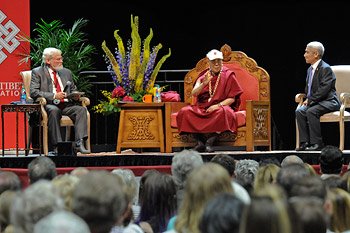His Holiness the Dalai Lama has visited five states in nineteen days during his United States tour this month. He left Dharamshala on June 10, arriving in the US to attend meetings, give teachings and to visit President Barack Obama.
An audience consisting of 275 people was graced with His Holiness’ presence during the Women in Compassionate Leadership breakfast in Los Angeles, California on June 17. During this event the Dalai Lama touched upon the importance of education for the betterment of the world.
“Education is the key to a healthy and happy humanity,” he stated. “Having a healthy mind is crucial to our physical health. Destructive emotions like anger disturb our peace of mind and distract our ability to judge right from wrong. Love and compassion—the essence of all major religious traditions—are fundamental to human happiness. What we need is an education in warm-heartedness. And since women are more sensitive to others’ needs, it’s possible that if a majority of the world’s 200 or so countries were women, the world might be a more peaceful place.”
His Holiness also spoke in depth about the root causes of anger and attachment, their detrimental effects, and how they can be overcome. He then participated in a live Facebook interview with well known journalist and activist Maria Schriver.
The following day His Holiness was welcomed to the Dieu Ngu Buddhist Temple in Westminster, California. He talked about the connection between compassion and human wellbeing saying: “Scientists have found evidence to show that basic human nature is compassionate. Whether we believe in religion or not, affection and compassion are key factors in our peace of mind, while constant anger and fear are said to undermine our immune system.”
The Dalai Lama also mentioned both Pali and Sanskrit traditions. “While the Pali tradition thrives in Burma, Thailand, Laos, Cambodia and Sri Lanka, the Sanskrit tradition, including the Nalanda tradition, was conveyed to China from where it spread to Korea, Japan and Vietnam. Later, in the 8th century, the Nalanda tradition was brought to Tibet directly from India by the Abbot Shantarakshita. Within the Tibetan Buddhist tradition we distinguish two waves of translation, the old and the new, depending on whether they took place before or after Rinchen Zangpo, a translator during the 11th century. The Tibetan language evolved during the process of translation of Indian Buddhist literature so that it remains today the language most capable of accurately expressing the Buddha’s teachings,” he said.
On the morning of June 19 over 400 members of the Tibetan Association of Southern California met His Holiness the Dalai Lama. During his discourse he spoke about the political unrest that Tibet is currently facing along with the severe persecution of countless Tibetans by the Chinese government.
“We’re passing through the most difficult period in the last 2,000 years of our recorded history,” he stated. “We used only to quarrel among ourselves to the detriment of the entire three provinces of Tibet, but now we’re facing a life or death struggle for our culture and identity. This may be the fruit of our karma, yet among Tibetans in exile as well as those in Tibet, our spirit remains strong.”
Later that day His Holiness returned to the Dieu Ngu Buddhist Temple to deliver a keynote address for its inauguration ceremony. The Lam Rim prayer, Heart Sutra and the Mangala Sutta were some of the auspicious verses that were recited during the opening ceremony.
The Dalai Lama explained the significance of the Heart Sutra stating: “We recited the Heart Sutra which is a concise rendering of the Perfection of Wisdom teachings that explain emptiness. The sutra says that the five aggregates are also empty of inherent existence, a declaration of the selflessness of phenomena in addition to the selflessness of persons.”
A discourse, Compassion and Universal Responsibility, followed on June 21 at the University of Utah. During the event he also received the President’s Medal for his ceaseless quest to make the world a more peaceful place.
At the Coors Event Centre on June 23 His Holiness spoke on the topic of Geshe Langri Thangpa’s Eight Verses of Training the Mind and later that day gave another speech, Educating The Heart and Mind.
His Holiness the Dalai Lama ended his US visit with a discourse, Compassion as a Pillar of World Peace, at the Indiana Farmers Coliseum. He will return to India before his birthday on July 6 which he will celebrate in Mungod settlement in South India.






 Print
Print Email
Email